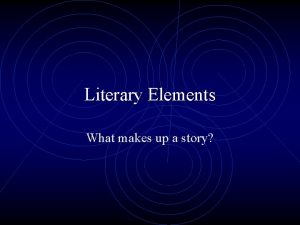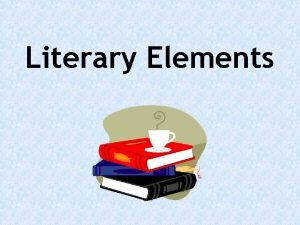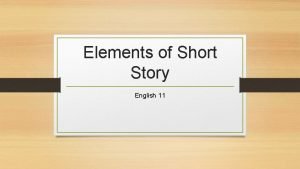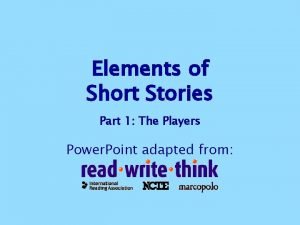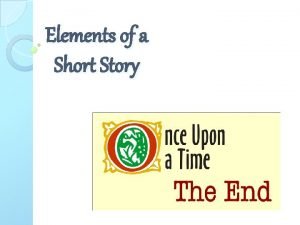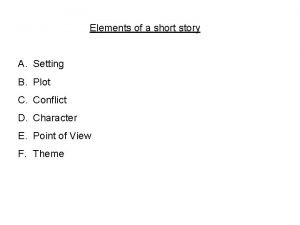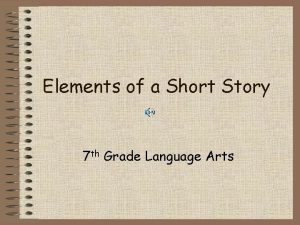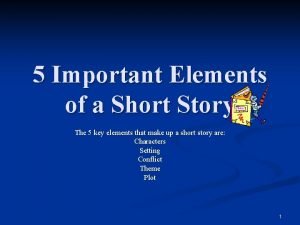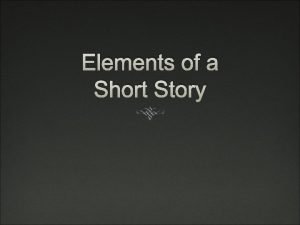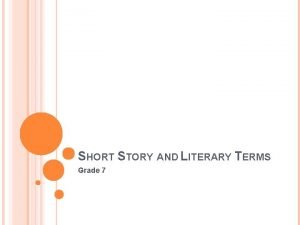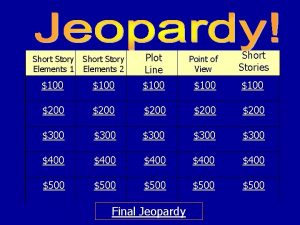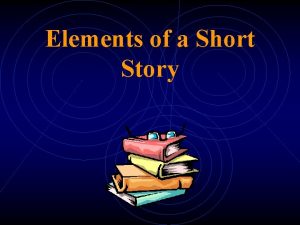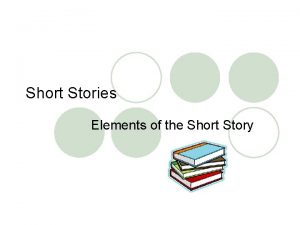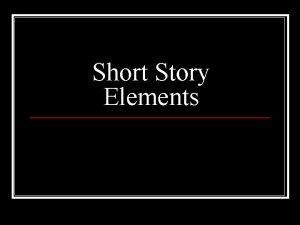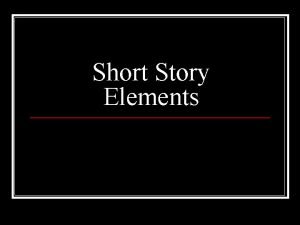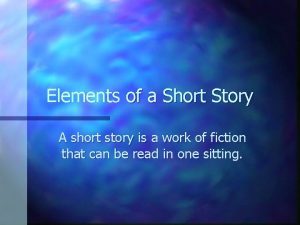ELEMENTS OF A SHORT STORY A SHORT STORY











- Slides: 11

ELEMENTS OF A SHORT STORY

A SHORT STORY IS… • A brief, imaginative narrative containing few characters, simple plot, conflict, and suspense which leads to a climax and a swift conclusion. • Can be read in one sitting

SETTING • The time and location in which the story takes place. • Can be essential or non-essential depending on the story Things to consider when examining how the setting contributes to a story… 1. Place: geographical location 2. Time: historical period, time of day, year, etc. 3. Weather Conditions: rainy, sunny, stormy, etc. 4. Social Conditions: customs, mannerisms, speech, dress, etc. 5. Mood or Atmosphere: What feeling is created at the beginning of the story? Is it bright and cheerful? Or dark and frightening?

PLOT • The sequence of events in a story or play. • Short stories usually have only one plot, so they can be read in one sitting. • 5 essential parts of a plot. . 1. Introduction: the beginning where the characters and setting are revealed 2. Rising Action: events in the story become complicated and the conflict is revealed 3. Climax: highest point of interest and the turning point of the story. 4. Falling Action: events and complications begin to be resolved. 5. Denouement (Resolution): the final outcome or untangling of events in the story.

CONFLICT • The opposition of forces which ties one incident to another and makes the plot move. Two types of conflict: 1)External: a struggle with a force outside one’s self 2)Internal: a struggle within one’s self.

Four kinds of conflict… 1) Man v Man (physical)- leading character struggles against other men, forces of nature, or animals. 2) Man v Circumstances (classical)- leading character struggles against fate, or the circumstances they face. 3) Man v Society (social)- leading character struggles against ideas, practices, or customs of other people. 4) Man v Himself/Herself (psychological)- leading character struggles with his/her own soul, ideas of right or wrong, physical limitations, choices, etc.

CHARACTER • Two meanings: 1)The person in a work of fiction 2)The characteristics of a person Persons in a work of fiction: - Protagonist: main character, typically the “good guy” - Antagonist: the person/thing/object… that opposes the protagonist

• Characteristics of a person Character is revealed in several ways: a) his/her physical appearance b) What he/she says, thinks, feels and dreams c) What he/she does or does not do d) What others say about him/her and how others react to him/her Characters are convincing if they are consistent, motivated, and life-like.

• Characters are… 1. Individual- round, many sided and complex personalities 2. Developing- dynamic, many sided personalities that change, for better or worse, by the end of the story 3. Static- stereotype, have one or two characteristics that never change and are emphasized… brilliant detective, scrooge, wicked stepmother…

POINT OF VIEW • First person: the story is told by the protagonist or one of the characters who interacts closely with the protagonist or other characters. Uses pronouns I, me, we, etc. The reader only knows what the narrator sees, knows and feels. • Omniscient: The story is narrated by someone outside the story. Moves from character to character, event to event. The reader knows thoughts, feelings, and motivations of multiple characters.

THEME • The controlling idea or central insight • The meaning or main idea the author is trying to convey Common themes: -things are not always as they appear -love is blind -believe in yourself -people are afraid of change -don’t judge a book by it’s cover
 Tall+short h
Tall+short h Short story introduction
Short story introduction Elements of a short story video
Elements of a short story video Cinderella example of short story with elements
Cinderella example of short story with elements Five elements of
Five elements of Elements of a short story powerpoint
Elements of a short story powerpoint Parts of short story
Parts of short story Short story setting
Short story setting Elements of a short story grade 7
Elements of a short story grade 7 Short story with 5 elements of plot
Short story with 5 elements of plot Identify the elements of short story. *
Identify the elements of short story. * Grade 7 short story unit
Grade 7 short story unit


